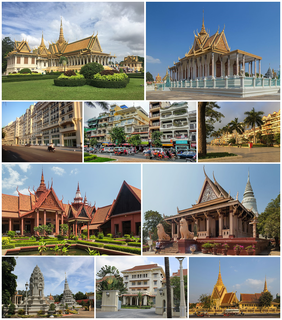
Phnom Penh is the capital and most populous city of Cambodia. It has been the national capital since the French protectorate of Cambodia, and has grown to become the nation's economic, industrial, and cultural centre.

The music of Cambodia is derived from a mesh of cultural traditions dating back to the ancient Khmer Empire, India, China and the original indigenous tribes living in the area before the arrival of Indian and Chinese travelers. With the rapid Westernization of popular music, Cambodian music has incorporated elements from music around the world through globalization.
Articles related to Cambodia and Cambodian culture include:

Sinn Sisamouth was a Cambodian singer-songwriter active from the 1950s to the 1970s.

Pradal Serey or Kun Khmer is an unarmed martial art and combat sport from Cambodia. It is a martial art practiced by young, athletic people. The official Khmer name of the sport is Kbach Kun Pradal Khmer. In Khmer, pradal means fighting or boxing and serey means free. Thus, pradal serey may be translated as "free fighting" or "free boxing". The sport consists of stand up striking and clinch fighting where the objective is to knock an opponent out, force a technical knockout, or win a match by points.

Pailin is a province (khaet) in western Cambodia at the northern edge of the Cardamom Mountains near the border of Thailand. This province is surrounded by Battambang province, and was officially carved out of Battambang to become a separate administrative division after the surrender of the Ieng Sary faction of the Khmer Rouge in 1996. Pailin is known to much of the world for having long been a stronghold of the Khmer Rouge, remaining under their control long after they were defeated in 1979 and serving from 1994 to 1998 as the capital of the Provisional Government of National Union and National Salvation of Cambodia. Within Cambodia Pailin is known for its natural resources, namely precious gems and timber.

The Pinpeat is the largest Khmer traditional musical ensemble. It has performed the ceremonial music of the royal courts and temples of Cambodia since ancient times. The orchestra consists of approximately nine or ten instruments, mainly wind and percussion. It accompanies court dances, masked plays, shadow plays, and religious ceremonies. This ensemble is originated in Cambodia since before Angkorian era.

Maha Ghosananda was a highly revered Cambodian Buddhist monk in the Theravada tradition, who served as the Patriarch (Sangharaja) of Cambodian Buddhism during the Khmer Rouge period and post-communist transition period of Cambodian history. His Pali monastic name, 'Mahā Ghosānanda', means "great joyful proclaimer". He was well known in Cambodia for his annual peace marches.

Buddhism in Cambodia has existed since at least the 5th century. In its earliest form it was a type of Mahāyāna Buddhism. Today, the predominant form of Buddhism in Cambodia is Theravada Buddhism. It is enshrined in the Cambodian constitution as the official religion of the country. Theravada Buddhism has been the Cambodian state religion since the 13th century. As of 2013 it was estimated that 97.9 percent of the population was Buddhist.

Battambang is the capital of Battambang Province in northwestern Cambodia.
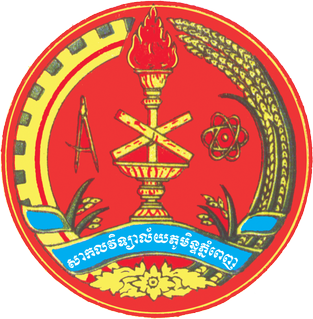
The Royal University of Phnom Penh is a national research university of Cambodia, located in the Phnom Penh capital. Established in 1960, it is the country's largest university. It hosts around 20,000 students in undergraduate and postgraduate programmes. It offers degrees in fields such as sciences, humanities and social sciences, engineering as well as vocational courses in fields such as information technology, electronics, psychology and tourism. RUPP provides Cambodia's foremost degree-level language programmes through the Institute of Foreign Languages. RUPP has full membership in the ASEAN University Network (AUN).

Cambodia has increasingly become involved in sports over the last 30 years.
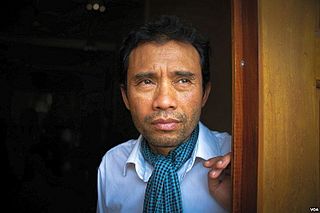
Arn Chorn-Pond is a Cambodian musician, human rights activist, and a survivor of the Khmer Rouge regime. He is an advocate for the healing and transformative power of the arts, and especially music.
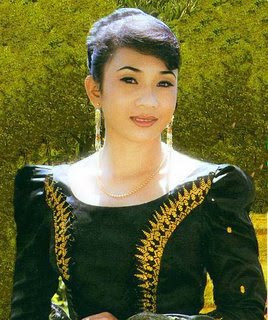
Pisith Pilika, was a Cambodian ballet dancer and actress. Born Oak Eap Pili, Pilika appeared in hundreds of movies and thousands of karaoke videos from the 1980s through the 1990s. Her career was brought to a premature end when she was murdered in broad daylight at O'Russey Market in Phnom Penh. Though the crime amounted to one of the most high-profile killings in Cambodia’s recent history, no suspects have ever been identified or arrested.
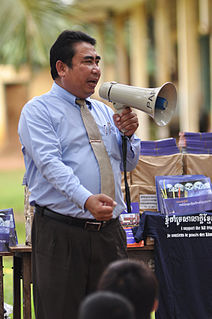
Reach Sambath was a Cambodian journalist and a former spokesperson and Chief of Public Affairs of the Extraordinary Chambers in the Courts of Cambodia (ECCC), commonly known as the Khmer Rouge Tribunal, set up to try the most senior Khmer Rouge leaders from 1975 to 1979. Sambath had a master's degree in journalism from Columbia University, New York, and a career as a university lecturer at the Royal University of Phnom Penh and a reporter in Cambodia with Agence France-Presse since the 1990s.
The Fall of Phnom Penh was the capture of Phnom Penh, the capital of the Khmer Republic, by the Khmer Rouge on 17 April 1975, effectively ending the Cambodian Civil War. At the beginning of April 1975, Phnom Penh, one of the last remaining strongholds of the Khmer Republic, was surrounded by the Khmer Rouge and totally dependent on aerial resupply through Pochentong Airport.
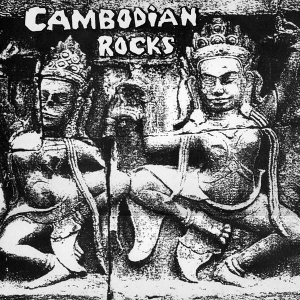
Cambodian Rocks is a compilation of 22 uncredited, untitled Cambodian psychedelic and garage rock songs from the late 1960s and early 1970s. When the tracks were recorded, musicians in the thriving music scene were combining Western rock and pop genres with their own styles and techniques. When the Khmer Rouge came to power in 1975, artists were among those viewed as a threat to the regime's agrarian socialist vision, and several of the performers on the album are believed to have been among those killed during the ensuing Cambodian genocide of 1975–1979. A great deal of information about them and their creative output was lost, although some has been recovered since the album's release.
Cambodian rock of the 1960s and 1970s was a thriving and prolific music scene based in Phnom Penh, Cambodia, in which musicians created a unique sound by combining traditional Cambodian music forms with rock and pop influences from records imported into the country from Latin America, Europe, and the United States. U.S. armed forces radio that had been broadcast to troops stationed nearby during the Vietnam War was also a primary influence. This music scene was abruptly crushed by the Khmer Rouge communists in 1975, and many of its musicians disappeared or were executed during the ensuing Cambodian genocide. Due to its unique sounds and the tragic fate of many of its performers, the Cambodian rock scene has attracted the interest of music historians and record collectors, and the genre gained new popularity upon the international release of numerous compilation albums starting in the late 1990s.

The kse diev or khse mhoy is a Cambodian musical bow with a single copper or brass string and a gourd resonator. The resonator is held to the bow with a nylon cord and is open at the other end. The nylon cord holds on the resonator and acts as a loop around the copper string, bringing it to the stick. The nylon loop acts as the nut on a guitar, the place below which the string vibrates and sound begins.














